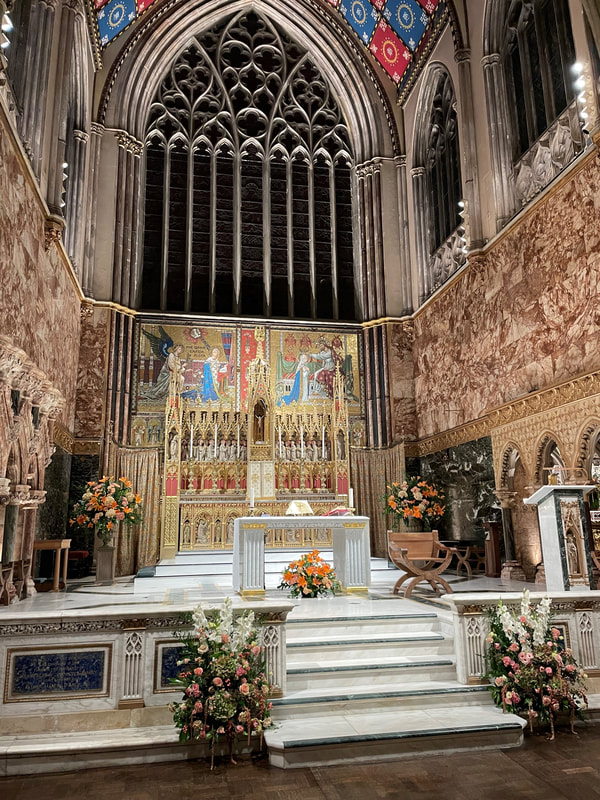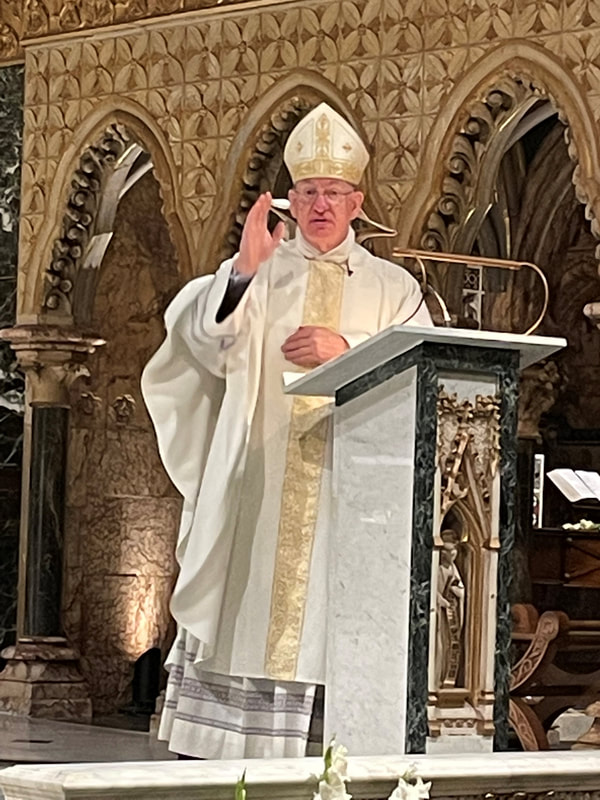annual thanksgiving mass to celebrate 127 years
|
We celebrated our Annual Thanksgiving Mass on Friday 4 November, at the Church of the Immaculate Conception in Mount Street, London, W1.
The Right Reverend Richard Moth, Bishop of Arundel and Brighton, was Principal Celebrant. During the service, he preached on the life of St Charles Borromeo and how this unlikely saint had influenced the work of St Francis Leprosy Guild. Bishop Richard also blessed our Book of Remembrance in memory of the generous donors whose legacies continue to support people affected by leprosy. Order of Service After the service, there was an Assembly and Reception at Farm Street. Michael Forbes Smith, KHS, Chair of the trustees, presided on behalf of St Francis Leprosy Guild. |
|
Chair of Trustees' Address To St Francis Leprosy Guild Annual Assembly - 4 November 2022
|
Bishop Richard, friends; welcome. And thank you Bishop Richard for celebrating our 127th Anniversary Mass so beautifully: and for your moving homily drawing our attention to the works of St Charles Borromeo from which we in the Guild can draw such inspiration and encouragement. And thank you Katharine for saying the bidding prayers. Lord, we remember the many people around the world afflicted with leprosy. May we follow the example of your Son Jesus and St Francis of Assisi and show them love and compassion. We pray that they may be freed from the disease and its stigma. We give thanks for those who have been cured. We remember those who are permanently marked by the disease and all who care for them. Amen" |
In 2020, our 125th anniversary year, the Guild became a Charitable Incorporated Organisation. While the rules do not require any public meetings, trustees resolved to hold an annual assembly after our annual benefactors’ Mass, to show our openness to and dependence on our current benefactors and those who have remembered us in their wills, as Bishop Richard remembered and blessed them on our behalf during Mass.
Our mission - the alleviation of the suffering caused by leprosy throughout the world – has remained unchanged since our foundation in 1895. But we could not do it without your generous financial support.
In past years we have greatly appreciated the presentations by medical students whose elective visits studying leprosy were part-funded by the Guild. Sadly Covid-19 has interrupted the supply! Hopefully we will have more in future years. But meanwhile you will have to be satisfied by myself.
This is the last public event that I shall attend as Chair of the Guild. So it is a poignant occasion for me; and if you will indulge me, I want to start by saying several thank yous to all those who have given so willingly of their time and energies to get us to where we are today from where we were when I took over as Chair in 2014.
Until 2017, that meant our trustees, our delightful part-time administrator, Therese Marcelle, who died so tragically and suddenly in July 2017 RIP, and a few devoted volunteers – of whom I’m delighted to welcome one - Catherine Dell, who has come down from East Anglia to be with us this evening.
Trustees of charities seldom get thanked for the unremitting work they do. It’s no sinecure these days: the Charity Commission’s demands on trustees are ever more onerous. I should like, therefore, to rectify that omission this evening, beginning with those that have retired since 2014.
When Chris Wyatt arrived as our Honorary Treasurer in 2014, he very quickly warned us that we would run out of funds in around five years’ time if we did not grasp that existential nettle and make radical changes to address it. He and Maggie Hood, whose father Sir Harold was a distinguished predecessor of mine as President from 1960 to1994, were instrumental in bringing the Guild’s first Strategy Review we called “A Pilgrimage of Hope” to the Board of Trustees – a harrowing document at the time but revitalising in the end. With the support of all our now retired trustees - Veronica Melia, Claire Kitione, Paul Leavy, Philip Newill, Sr Helen McMahon and Gosia Brykczynska- we took the momentous decision in 2017 to implement its recommendations.
Some of those retired trustees are here this evening. Sr Helen retired this year as Honorary Secretary, the hundredth anniversary of the Franciscan Missionaries of Mary’s association with the Guild. In fact the FMM’s provided the administration of the Guild from the 1920’s until the 1990’s.
Gosia who has also just retired was our doyen trustee, a constant support and expert adviser on the disease and the centres we supported. And Philip and Paul still remain members of the Grants Sub-Committee; we cannot thank you both enough. Our continued thanks go to our Spiritual Director, the Very Reverend Father Michael Copps.
And since then, our Board of Trustees has been bolstered with the arrival of several new and highly qualified trustees: Professor Robin Graham-Brown, formerly our medical adviser, who joined the Board in 2018 has supported me since my arrival and given unstintingly of his time and expertise. Professor Noel Gill also joined in 2018, and I’m greatly relieved that he is here to answer any of the technical questions you may have that are beyond my ken! Sadly, Nicholas Hall who joined in 2020 died suddenly in November that year RIP, having already provided sterling legal advice. And since then we have been blessed by the additions of Cecilia Taylor-Camara, Liam Allmark representing the Bishops’ Conference, Clare Barton, Nalini Nathan, Maggie Burgess, Michael Heathcote our new Hon Treasurer, Edward Reed and Bill Dibb. To all of them I cannot say how grateful the Guild is for the commitment you make to our work.
Returning to our situation in 2017: the fundamental reality we faced was clear – the charity fundraising environment had changed beyond all recognition since the days when the FMM’s provided full-time administrative support. The administrative workload now forced on charities like us, even before we begin to think about our charitable objectives, is simply too great for trustees to manage without the expertise of trained and experienced charity executives.
Kieran Kettleton, who I’m delighted to welcome here this evening, first picked up the threads of our administration in 2017, before taking over as our first professional director. Kieran quickly found the answer to both our fundraising difficulties and SFLG’s future operational strategies in the changing landscape of leprosy since the 1990’s and, with the trustees, set us on the paths which have brought us the success we can report to you this evening.
As most of you will know, despite having found a cure – made available worldwide free through the World Health Organization (WHO) in 1991 – since the millennium, 200,000 new cases were, and still are, being reported to WHO every year. In response, WHO launched its 2016-2020 Global Leprosy Strategy "Accelerating Towards a Leprosy- Free World" and after limited success, its 2021-2030 Strategy “Towards Zero Leprosy”. These aspirational documents gave us a narrative on which to base our fundraising effort which has so far been successful – but don’t misunderstand me, we always need every bit of support we can get!
But it also demanded that we up our act: to move from a purely reactive provider of financial support to the falling numbers of long-established leprosy patients (without, of course, abandoning them) to a proactive outreach into remote areas and squalid slums where the disease remains endemic.
There were the odd hurdles to negotiate on the way - like the GDPR and the safeguarding requirements of the Charity Commission, not to mention completely overhauling our “back office” and operational hard and software.
But we overcame them and launched in 2020 a three-pronged strategy. First SFLG’s traditional support of leprosy sufferers and their dependents who still need our support; second, supporting multi-year projects that concentrate on primary health care and case-finding leading to early diagnosis and treatment in areas where leprosy remains endemic: in 2020-2021we launched six active case-finding projects, each over a three year period, in Bangladesh, India, Nepal and Pakistan – and three more are in the pipeline this year in India, Bangladesh and Africa. And third, funding applied research in the fields of diagnostics, treatment and the reduction of transmission of the disease.
In November 2020, when Kieran retired, we recruited Clare McIntosh as our full-time Chief Executive Officer who has carried on the good work with panache - she and our new Programme Manager, Charlotte John, will shortly be on their way to India where they have been invited to give a presentation at the International Leprosy Conference in Hyderabad. We have become, in today’s jargon, a “thought leader” which is a great matter of pride to all of us; more importantly it means we have a voice and greater visibility, which then comes back to our ability to fund our work as it grows.
In 2021, Clare devised a new mnemonic to reflect more clearly the different strands of our activities: “TRACE”: training, research, active case-finding, care and emergency support. Some other leprosy organisations have actually told us they wish they had thought of something so simple, concise yet comprehensive themselves to describe their activities – all signs of our growing international recognition.
I’ve mentioned our active case-finding projects. SFLG continues to fund our long-term partnerships with centres caring for leprosy patients and their dependents – 37 in 13 countries (one goes back 98 years). And we provided emergency food aid for all those centres as part of our Covid-19 emergency reaction package. I can’t emphasise enough how much of a distraction Covid-19 has been to the fight to end leprosy.
We may be on the final mile, but there is nothing harder than going the final mile. I don’t need to tell you about the cost of living crisis – one effect will almost certainly be cuts to governments’ international aid budgets. And even if we could cure all those leprosy sufferers today, over four million people would still have to live out their lives with disabilities caused by leprosy. Many are forgotten by their own countries and governments. If organisations like the Guild didn’t care for them and the centres that provide for them – with your help - no one would. We maintain close relationships with the centres we support including many run by religious orders who are heroes in their own right, following the example of St Francis himself.
Your donations have achieved so much for our beneficiaries this year, as we report in the Annual Review – 120,000 people screened for leprosy, 4,000 diagnosed with leprosy and 30,000 receiving direct treatment.
In conclusion, please:
- Keep telling people leprosy is not a thing of the past
- Keep praying for our team, our centres and the people we support
- Keep giving what you can
- Think about whether you could mention us in any way in your will
MFS
4 November 2022







